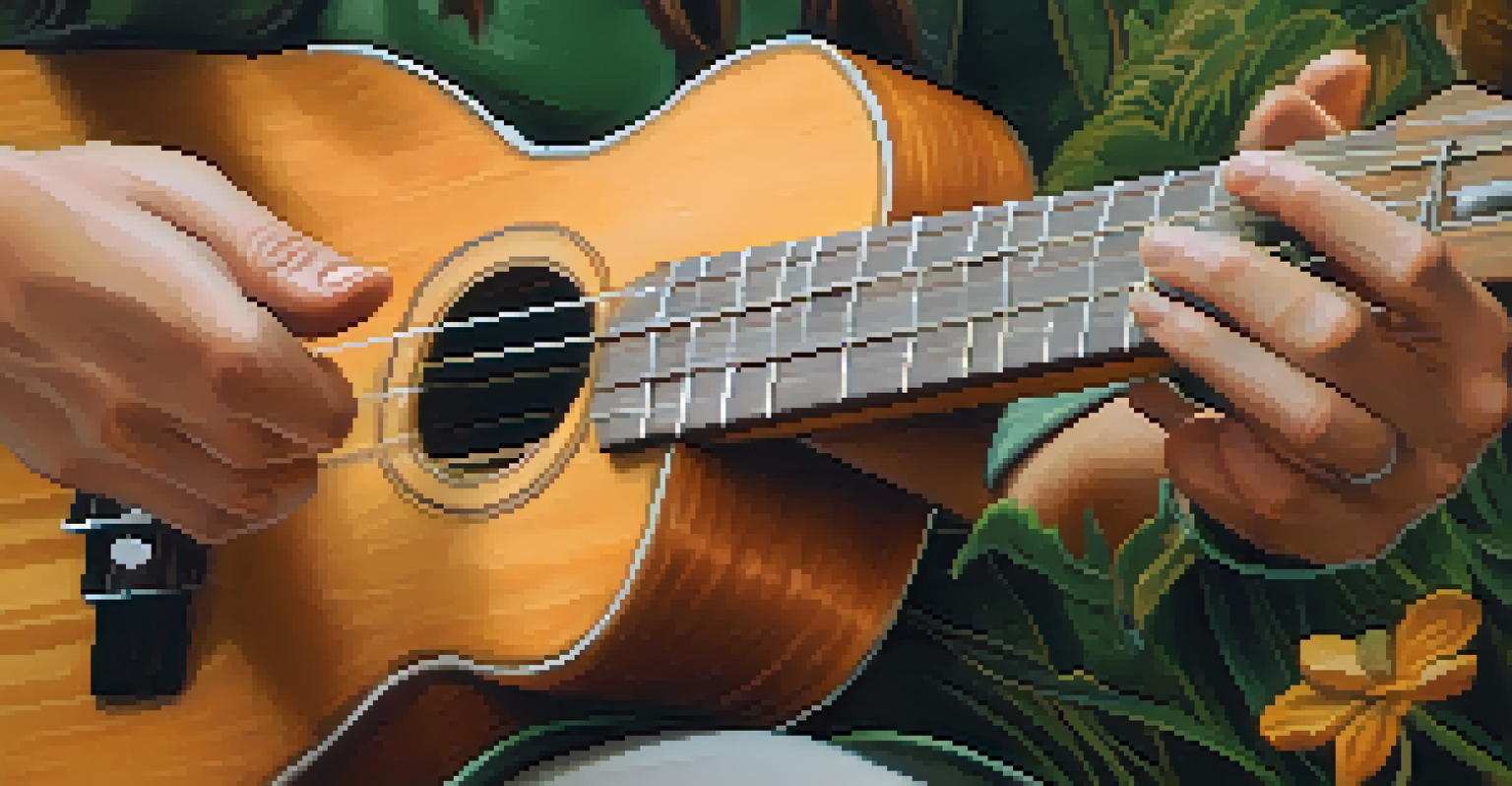Advanced Fingerstyle Techniques for Ukulele Players

Understanding Fingerstyle Basics Before Advancing
Before diving into advanced fingerstyle techniques, it’s essential to have a solid grasp of the basics. Understanding how to use your fingers effectively can set the foundation for more complex patterns. Start by practicing simple fingerpicking exercises to develop coordination and strength in your fingers.
Music is the shorthand of emotion.
Think of fingerstyle as a conversation between your fingers and the strings; each finger has its role, just like different voices in a choir. By mastering the basic picking patterns, you’ll find it easier to explore more intricate techniques later on. Consistency is key here, so spend time regularly honing these foundational skills.
Once you're comfortable with basic fingerpicking, you can begin to add embellishments and variations to your playing. This sets the stage for advanced techniques where creativity can flourish, allowing you to express yourself more freely through the instrument.
Exploring Alternate Tunings for Unique Sounds
Alternate tunings can be a game-changer for ukulele players looking to expand their sound palette. By tuning your ukulele differently, you can unlock a world of new chord shapes and fingerstyle patterns. For example, try tuning your ukulele to G-C-E-A to A-C-E-G for a fresh perspective on familiar songs.

These alternate tunings can inspire new creativity, making familiar pieces feel brand new. It’s like viewing a painting from a different angle; you notice elements you might have missed before. Experimenting with different tunings can lead to innovative arrangements and unique compositions.
Master Fingerstyle Basics First
Building a solid foundation in basic fingerpicking techniques is crucial for advancing to more complex styles.
As you explore alternate tunings, keep a journal of your discoveries. Note down the chords and fingerstyle patterns that resonate with you, and don’t hesitate to experiment with your own arrangements. This personal touch can help you achieve a distinctive sound that sets you apart from other players.
Incorporating Harmonics for a Magical Touch
Harmonics are a beautiful way to add ethereal sounds to your ukulele playing. By lightly touching the string at specific points, you can create bell-like tones that enhance your fingerstyle arrangements. This technique requires some practice, but the stunning results are well worth the effort.
The only thing better than singing is more singing.
Imagine harmonics as the fairy dust sprinkled over your music; they add a layer of enchantment that captivates your audience. Start by practicing natural harmonics at the 5th, 7th, and 12th frets, and incorporate them into your fingerstyle pieces. You’ll be amazed at how even a few harmonics can elevate the overall feel of your music.
As you grow more comfortable with harmonics, experiment with combining them with regular fingerpicking patterns. This interplay between conventional notes and harmonics can create a mesmerizing effect, making your playing more dynamic and engaging.
Mastering Percussive Fingerstyle Techniques
Percussive fingerstyle techniques add an exciting rhythmic element to your ukulele playing. By incorporating tapping, slapping, and muting, you can transform your instrument into a percussive powerhouse. It’s a great way to keep the rhythm while simultaneously playing melody and harmony.
Think of your ukulele as a drum as well as a melodic instrument; the percussive sounds complement the notes you play, creating a fuller sound. Start with simple techniques, like tapping the body of the ukulele while you play, and gradually introduce more complex rhythms. This can be a fun way to challenge yourself and explore different musical styles.
Explore Alternate Tunings
Experimenting with alternate tunings can unlock new creative possibilities and unique sounds in your playing.
As you develop your percussive style, listen to artists who excel in this technique. Analyzing their approach can inspire you to find your own unique sound and rhythm. Remember, practice makes perfect—so keep experimenting and refining your skills!
Using Fingerstyle Patterns to Create Unique Arrangements
Fingerstyle patterns can be the backbone of your ukulele arrangements, offering a structure for creativity. By learning various picking patterns, you can tailor your songs to showcase your unique style. Start by mastering a few common patterns before mixing and matching them to create something entirely new.
Consider these patterns as building blocks; like a Lego set, you can combine them in limitless ways to create unique musical pieces. For example, a simple pattern can be altered by changing the rhythm or adding additional notes, giving it a fresh twist. The more patterns you learn, the more options you have to express yourself.
Don’t shy away from experimenting and improvising! Allow your creativity to flow as you explore different combinations of patterns. This not only enhances your arrangements but also deepens your connection to the music you create.
Combining Fingerstyle with Chord Melodies for Depth
Chord melodies are a fantastic way to combine harmony and melody in your fingerstyle playing. This technique involves playing the melody on the top strings while simultaneously strumming or picking chords on the lower strings. The result is a rich, full sound that captivates listeners.
Think of chord melodies as a conversation—your fingers are having a dialogue between the melody and the harmony. Start with simple songs to practice this technique, gradually incorporating more complex melodies and chord progressions as you grow more confident. This method can transform your playing, making it more expressive and nuanced.
Combine Techniques for Depth
Incorporating a mix of harmonics, percussive elements, and chord melodies enriches your fingerstyle arrangements.
As you become familiar with chord melodies, consider arranging your favorite songs in this style. It’s a beautiful way to make the music your own, showcasing your personality and interpretation while engaging your audience.
Creating Your Own Fingerstyle Compositions
Once you’ve mastered various techniques, it’s time to unleash your creativity and compose your own fingerstyle pieces. Start by identifying the emotions or stories you want to convey through your music. This heartfelt approach can help guide your compositions and make them more personal.
Think of composition as painting a picture; you have colors (techniques) at your disposal to express your vision. Begin with a simple melody and build upon it, layering in different fingerstyle techniques you’ve learned along the way. This process allows for exploration and experimentation, which can lead to unexpected and delightful results.

Don’t be afraid to share your compositions with others! Sharing your music not only builds confidence but also invites feedback that can lead to further growth. Remember, every great composer started somewhere—trust your instincts and enjoy the journey.
Practicing Advanced Techniques for Continuous Growth
The key to mastering advanced fingerstyle techniques is consistent practice. Set aside time each week to focus on specific techniques, breaking them down into manageable sections. This focused approach allows for gradual improvement and prevents overwhelm, making the learning process enjoyable.
Think of practice like a workout; the more you engage your fingers, the stronger and more agile they become. Incorporate a variety of exercises that challenge your skills and keep your practice sessions fresh and exciting. Remember, it’s not just about the quantity of practice but the quality of focus during those sessions.
Finally, don’t forget to celebrate your progress! Acknowledge the milestones you achieve, no matter how small, as they contribute to your overall growth as a musician. With dedication and patience, you’ll find yourself continually evolving as a fingerstyle ukulele player.